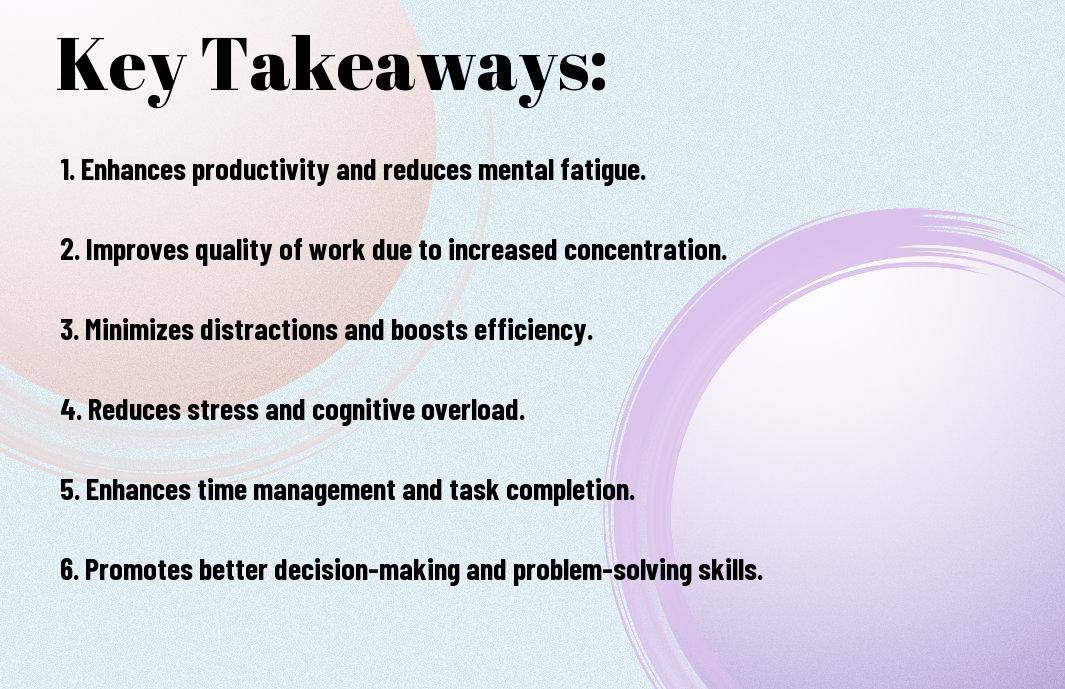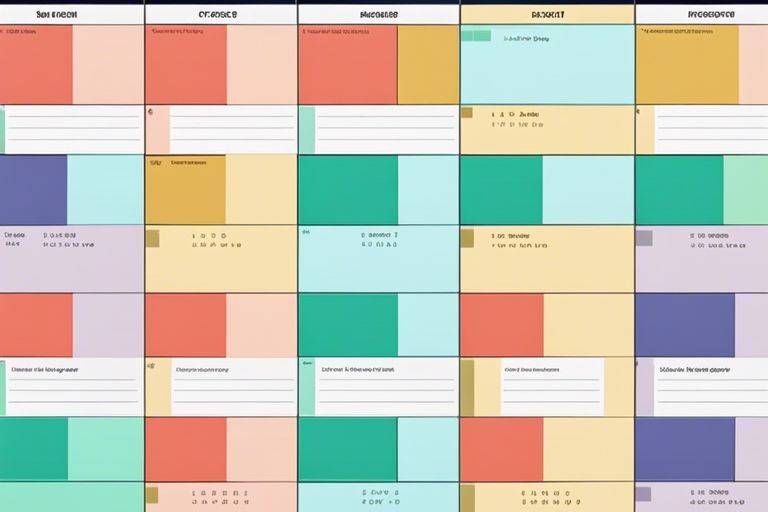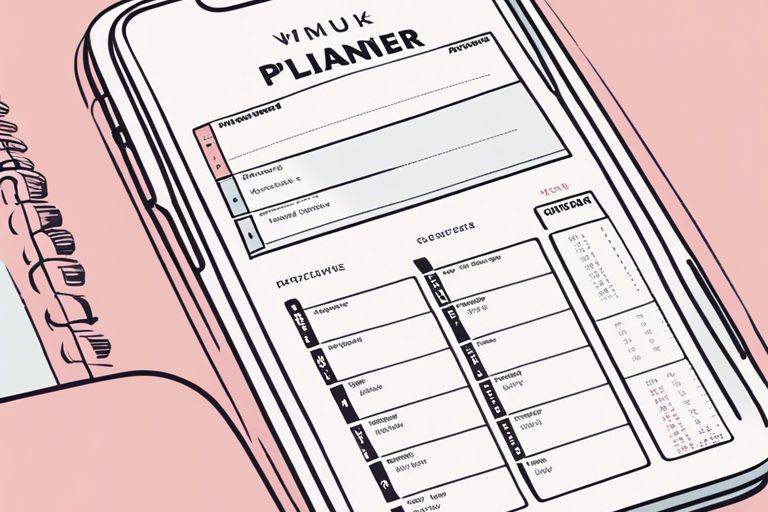Single Tasking! Tasking Efficiency is a crucial aspect of productivity that often gets overlooked in today’s fast-paced world. With the rise of multitasking and constant distractions, the ability to focus on a single task at a time has become a valuable skill. By concentrating on one task without dividing attention, individuals can achieve higher quality results in a shorter amount of time. This approach not only increases productivity but also reduces the likelihood of errors and burnout caused by cognitive overload.
Key Takeaways:
- Increased productivity: Focusing on one task at a time allows for better concentration and higher efficiency in completing tasks.
- Reduced stress: Single-tasking helps in minimizing overwhelm and stress that can be caused by multitasking.
- Improved quality of work: By giving full attention to one task, you are likely to produce higher quality results.
- Enhanced time management: Single-tasking helps in prioritizing tasks and managing time effectively.
- Better focus and attention: Concentrating on one task enables you to maintain better focus and attention to detail.
- Enhanced creativity: When you focus on one task, your brain has the space to think creatively and come up with innovative solutions.
- Reduced mental fatigue: Single-tasking can prevent mental fatigue that comes from continuously switching between tasks.


Understanding Single Tasking
Definition and Key Concepts
Understanding the concept of single tasking is imperative in a world filled with constant distractions. Single tasking involves focusing on one task at a time without the interference of other activities. It is a practice that encourages individuals to devote their full attention and energy to completing one task before moving on to the next.
History of Single Tasking in Productivity
Understanding the history of single tasking in productivity reveals that it has roots in the early productivity movements of the 20th century. Productivity experts such as Frederick Taylor and Henry Gantt advocated for a focused approach to work, emphasizing the importance of concentrating on one task to achieve optimal results.
Plus, by embracing single tasking, individuals can experience increased productivity, improved focus, and reduced stress levels. Single tasking allows individuals to work more efficiently and effectively, ultimately leading to better outcomes in both professional and personal settings.
The Science Behind Single Tasking
Cognitive Studies on Attention and Performance
On the cognitive front, numerous studies have shown that multitasking can significantly impair performance. When individuals try to juggle multiple tasks simultaneously, they experience an increase in cognitive load, leading to reduced efficiency and accuracy. Research indicates that the human brain is not designed to efficiently handle more than one complex task at a time. As tasks become more demanding, our ability to switch between them diminishes, resulting in errors and a decrease in overall productivity.
Neurological Impacts of Single Tasking
Tasking neurologically affects the brain’s ability to focus and retain information. When switching between tasks, the brain must disengage from one set of instructions and re-engage with another, leading to what is termed as “switching costs.” These switching costs can be taxing on the brain, causing cognitive fatigue and decreased performance over time. By practicing single tasking, individuals can reduce the neurological strain caused by constant task-switching, leading to improved focus and cognitive performance.

Comparing Single and Multi-Tasking
All too often, our modern work culture glorifies the ability to juggle multiple tasks simultaneously. However, it is crucial to understand that single-tasking, the practice of focusing on one task at a time, can lead to increased productivity and efficiency. Let’s examine into the comparison between single and multi-tasking to shed light on the benefits of focusing on one task at a time.
The Drawbacks of Multitasking
With the rise of technology and constant connectivity, the temptation to multitask has become a common phenomenon in today’s workplace. However, studies have shown that attempting to tackle multiple tasks simultaneously can actually lead to decreased productivity and a higher likelihood of errors. When we divide our attention among various tasks, our brain switches back and forth rapidly, resulting in a phenomenon known as “attention residue.” This residue can hinder our ability to fully concentrate on any one task and diminish the quality of our work.
With multitasking, the brain expends valuable energy on task-switching, causing mental fatigue and reduced cognitive performance over time. Furthermore, constantly shifting focus can impede our ability to retain information and problem-solve effectively. In a world where efficiency and quality are paramount, it is crucial to reconsider the habit of multitasking and recognize the advantages of single-tasking.
Efficiency and Quality: Single Tasking Versus Multitasking
Multitasking may give the illusion of productivity, but the reality is that it often leads to decreased efficiency and lower quality outcomes. When we focus on one task at a time, we can devote our full attention and energy to that specific task, resulting in deeper concentration and better performance. By immersing ourselves in a singular activity, we can produce higher-quality work in a shorter amount of time.
Multitasking not only affects the quality of our work but also our ability to innovate and think creatively. When we single-task, we allow ourselves the mental space to examine deeply into a task, fostering a flow state that can lead to enhanced problem-solving skills and innovative ideas. In a world where innovation is key to staying competitive, the value of focusing on one task at a time cannot be understated.

Strategies for Successful Single Tasking
Prioritization of Tasks
To be successful in single tasking, prioritizing tasks is crucial. By identifying the most important tasks that need to be completed, you can focus your energy and attention on each task one at a time. It’s crucial to consider deadlines, importance, and urgency when prioritizing your tasks.
Time Management Techniques for Single Tasking
With single tasking, time management becomes paramount. Implementing techniques such as the Pomodoro technique, time blocking, or the 2-minute rule can help you stay focused and productive. These techniques provide structures that enable you to allocate time efficiently to each task without feeling overwhelmed.
It’s important to establish a routine and set specific time blocks for each task. This helps create a sense of urgency and commitment to completing the task at hand efficiently.
Creating a Conducive Environment for Focused Work
One of the keys to successful single tasking is creating a conducive environment that minimizes distractions. Eliminate clutter and unnecessary items from your workspace to help you stay focused. Ensure that your workspace is well-lit and comfortable to enhance concentration and productivity.
Creating a designated work area can help signal to your brain that it’s time to focus. Avoid multitasking triggers such as having multiple browser tabs open or checking your phone constantly, as these can divert your attention away from the task at hand.
Tools and Apps to Aid Single Tasking
To aid you in your single tasking journey, there are various tools and apps available that can help enhance your productivity. Tools such as task managers, calendar apps, and distraction-blocking software can assist in organizing your tasks and keeping you focused. These tools can help you allocate time efficiently and remind you of upcoming deadlines, keeping you on track with your single tasking goals.
Understanding how to effectively utilize these tools can significantly improve your single tasking abilities and maximize your efficiency in completing tasks one at a time.
Overcoming Challenges in Single Tasking
Recognizing and Tackling Distractions
Distractions are one of the biggest hurdles in the path of single tasking. It’s important to identify the sources of distractions and take steps to eliminate or minimize them. Start by creating a dedicated workspace that is free from clutter and external disturbances. Turn off notifications on your devices and establish set times for checking emails or messages to avoid constant interruptions. Practice mindfulness techniques to bring your focus back to the task at hand whenever you feel your attention wandering.
Single Dealing with Procrastination
Single tasking can be derailed by procrastination, a common habit that hinders productivity. To combat procrastination, break down tasks into smaller, more manageable steps. Set clear deadlines and hold yourself accountable for completing each step. Identify the root causes of procrastination, such as fear of failure or perfectionism, and work on overcoming these barriers. Remember that taking the first step is often the hardest, but once you begin, momentum will carry you forward.
Plus
Managing External Pressure to Multitask
Recognizing the external pressures to multitask is crucial in maintaining your focus on single tasking. Colleagues, supervisors, or even societal norms may push for multitasking as a symbol of productivity. However, acknowledging the detrimental effects of multitasking on overall efficiency and the quality of work can help justify your decision to prioritize single tasking. Communicate your approach to others and educate them on the benefits of focusing on one task at a time.
This approach can lead to better outcomes and a more sustainable work ethic. Keep in mind, it’s not about doing more tasks simultaneously but about doing each task with focus, precision, and excellence.
Single Tasking in Different Spheres of Life
Single Tasking at the Workplace
After years of praising multitasking as the way to get things done faster, the concept of single tasking is gaining momentum in various spheres of life. One area where single-tasking can significantly boost productivity is in the workplace. By focusing on one task at a time, individuals can avoid distractions and explore deep into their work, leading to higher quality output in a shorter amount of time.
The Role of Single Tasking in Personal Development
One of the fundamental components of personal development is the ability to focus on individual goals and tasks with purpose and intent. By practicing single tasking in personal endeavors, individuals can cultivate a sense of mindfulness and intentionality in their actions. This approach allows for deeper engagement with tasks and projects, leading to a more profound personal growth experience.
Spheres of life where single tasking can have a transformative impact include professional development, relationships, and self-care. By dedicating full attention to each aspect, individuals can enhance their performance, nurture meaningful connections, and prioritize their well-being in a world filled with distractions.
Final Words
Now that we have explored the efficiency of focusing on one task at a time, it is evident that single tasking can lead to higher productivity, improved focus, and reduced stress levels. Research has shown that multitasking can decrease productivity by up to 40%, highlighting the importance of dedicating our attention to one task at a time. To probe deeper into the concept of single tasking versus multitasking, you can visit What is single-tasking (and is it better than multi-tasking)? for additional insights and strategies.
FAQ
Q: What is single tasking?
A: Single tasking is the act of focusing on and completing one task at a time without being distracted by other tasks or interruptions.
Q: How does single tasking differ from multitasking?
A: Single tasking involves concentrating on one task from start to finish, while multitasking involves trying to juggle multiple tasks simultaneously, which can lead to decreased productivity and increased errors.
Q: What are the benefits of single tasking?
A: Single tasking can lead to improved focus, increased productivity, better quality of work, reduced stress levels, and a greater sense of accomplishment.
Q: How can I start practicing single tasking?
A: To practice single tasking, create a to-do list, prioritize tasks, eliminate distractions, set specific time blocks for each task, and focus on one task at a time without switching between tasks.
Q: How can single tasking improve productivity?
A: Single tasking allows you to give your full attention to each task, leading to faster completion times, higher quality work, and a more efficient use of time compared to multitasking.
Q: What are some common obstacles to single tasking?
A: Common obstacles to single tasking include distractions such as notifications, emails, social media, interruptions from colleagues or family members, and the pressure to constantly be available and responsive.
Q: How can I overcome obstacles to single tasking?
A: To overcome obstacles to single tasking, establish boundaries with your time and attention, communicate your need for focus to others, use productivity tools to block distractions, and practice mindfulness techniques to improve concentration.
Expand Your Reading
Time Blocking – The Ultimate Guide to Allocating Specific Time Slots for Tasks
Zero-Based Calendar – Strategically Schedule Every Minute for Unparalleled Productivity
The One Thing – Gary Keller and Jay Papasan’s Focus on Making Everything Else Easier
Timeboxing – The Effective Limitation of Time Spent on Tasks
Breakdown Method – Tackling Overwhelming Tasks by Breaking Them Down



